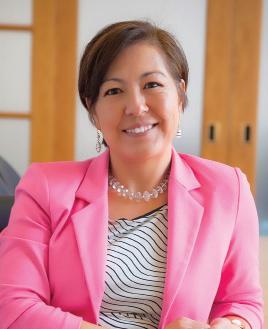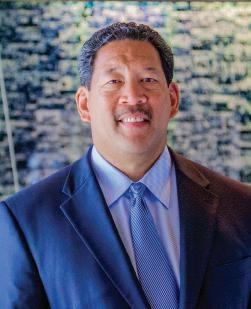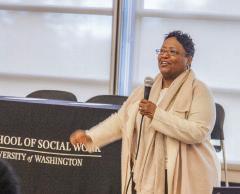
6 minute read
PREVENTION
We’re analyzing the social-emotional piece of the puzzle for these kids. I am thrilled to my heart to give kids all the skills they need to succeed.’’
TED HOWARD — PRINCIPAL, GARFIELD HIGH SCHOOL COMMUNITIES IN ACTION BOARD LEADERSHIP WORKGROUP What makes this program different is that it taps the talents of the community. This model proves that community can change lives for the better.’’
Advertisement
LEESA MANION — CHIEF OF STAFF, KING COUNTY PROSECUTOR’S OFFICE COMMUNITIES IN ACTION COMMUNITY BOARD MEMBER


We’re matching theory with practice on a large scale. Our collective involvement is creating a collective impact. This is a big deal.’’ This process is unprecedented for Seattle. I’m convinced it takes community to provoke change in our attitudes and our priorities. ’’
A Community in Action
In Southeast and Central Seattle, a School of Social Work–sponsored initiative is helping to prevent the most persistent social problems among young people.
Travel south from the University of Washington for several miles and you’ll find yourself in one of the most diverse communities in the country—Southeast and Central Seattle, where 59 languages are spoken, many families have low household incomes, and young people face numerous obstacles to achieving success in and out of school.
Many social services are available in this area, but the community wanted to see more coordination among them and a greater focus on evidencebased practices. They found a willing partner in the UW School of Social Work, which pioneered a preventive approach that has achieved striking results around the country: on average, a 25 percent reduction in crime, 32 percent reduction in alcohol use, and 33 percent reduction in tobacco use among youth.
The School-affiliated Social Development Research Group developed and refined this methodology, called Communities That Care (CTC), over the past 30 years and has brought it to dozens of communities nationwide.
Southeast and Central Seattle recently became the first of several communities in King County to implement CTC as part of a five-year, School-affiliated initiative called Communities in Action. ’’When communities
use their own data—the powerful voice of youth— to make local decisions about their community,
they are empowered.’’ MARGARET SPEARMON
UW SCHOOL OF SOCIAL WORK ASSOCIATE DEAN FOR COMMUNITY PARTNERSHIPS
Four of the more than 50 community leaders who have worked to identify data-driven, time-tested interventions that help youth succeed.

As Communities in Action project lead, Margaret Spearmon is helping to focus a community-wide lens on evidence-based prevention programs.
ASKING STUDENTS FIRST
In 2014, more than 2,300 young people in grades 6, 8, 10 and 12 in Southeast and Central Seattle took detailed surveys about challenges in their daily lives. Their responses revealed a picture of the most persistent problems: Physical fights and bullying. Feeling unsafe at school. Use of marijuana and other drugs. Depression and suicidal thoughts.
Getting firsthand information from those most affected is at the core of the CTC approach, which tailors prevention strategies to meet local needs.
“When communities use their own data—the powerful voice of youth—to make local decisions, they are empowered,” says Margaret Spearmon, the School’s associate dean for community partnerships, who oversees Communities in Action with Project Manager Vaughnetta Barton. “They make decisions that are focused on their needs, and they’re equipped to make changes to meet those needs. The approach builds relevance and ownership from the very first day. It allows communities to own their successes.”
ENLISTING COMMUNITY LEADERS
Spearmon and Barton created an advisory board of more than 50 community leaders to review the youth survey findings, identify the highest-priority needs and match those needs with the most As Communities in effective and proven Action puts the best of prevention measures. science into practice The diverse group in Southeast and brings together expertise Central Seattle, it is in early learning, education, foster care, building awareness of human services, faith prevention as a valuable communities, juvenile investment in the future justice, medical care, mental health, business of the community. and public policy. While the community drives the plan, human services agencies and schools put it into action. Communities in Action helps assess the efforts and build capacity where gaps exist. “We’re helping agencies examine and
The path to prevention
1KICKOFFCommunities in Action uses a five-step process that promotes healthy youth 2013: The School kicks development by supporting strengths off the Communities in and reducing negative behaviors. Action initiative in Seattle This approach, developed by a School with a small group of of Social Work–affiliated research “catalysts” to assess center, is part of a prevention system community readiness, that has 30 years of proven success in identify key leaders and communities across the country. recruit partners.
2ROADMAP
2014: Communities in Action forms an advisory board to articulate a vision and create a timeline for implementation. A youth survey is distributed to students.
adopt evidence-based practice models in a strategic and coordinated way,” says Spearmon.
In most communities, prevention takes a back seat to remedial efforts because the needs are so great. But remedial efforts are costly in terms of time, money and lost human potential. As Communities in Action puts the best of science into practice in Southeast and Central Seattle, it is building awareness of prevention as a valuable investment in the future of the community.
Communities in Action aims to not only decrease risk factors but also build protective factors into the community, schools and families. Such homegrown strengths—an encouraging teacher, a parent who recognizes a job well done, a neighbor who is there to listen, a fun after-school club—tend to be overlooked and undervalued. Yet decades of prevention science show that they can help bolster a young person’s self-esteem and resilience.
LABORATORY FOR LEARNING
It’s too soon to see measurable results in Southeast and Central Seattle, but past experience with this evidence-based model shows that within five years, the community can expect significantly improved outcomes for its young people.
In the meantime, the initiative is also giving MSW students an opportunity to see how their classroom learning can contribute to real-world impact. “Communities in Action is a great example of the reciprocity the School has with the many communitybased agencies where our students complete their field education,” says Spearmon. “It’s an acknowledgment of the community joining with us to educate future practitioners, and our joining with them to address the hard social problems of today. It’s how we’ll solve today’s most demanding problems—by working together.” n
Jaime Garcia (left), executive director, Consejo Counseling & Referral Services, and King County Prosecutor Dan Satterberg in a Communities in Action strategy session.
3RISK PROFILE 4 Early 2015: The youth survey data reveal three key risk factors for community youth: academic failure, early initiation into antisocial behavior, and laws and norms favorable to drug use.
ACTION PLAN
Late 2015: The Communities in Action advisory board develops a plan that identifies proven prevention measures to target the risk factors. The group also outlines measurable outcomes. 5LAUNCH 2016: The Communities in Action team helps launch the evidence-based interventions and monitors results to measure progress toward the initiative’s goals for positive youth development.






